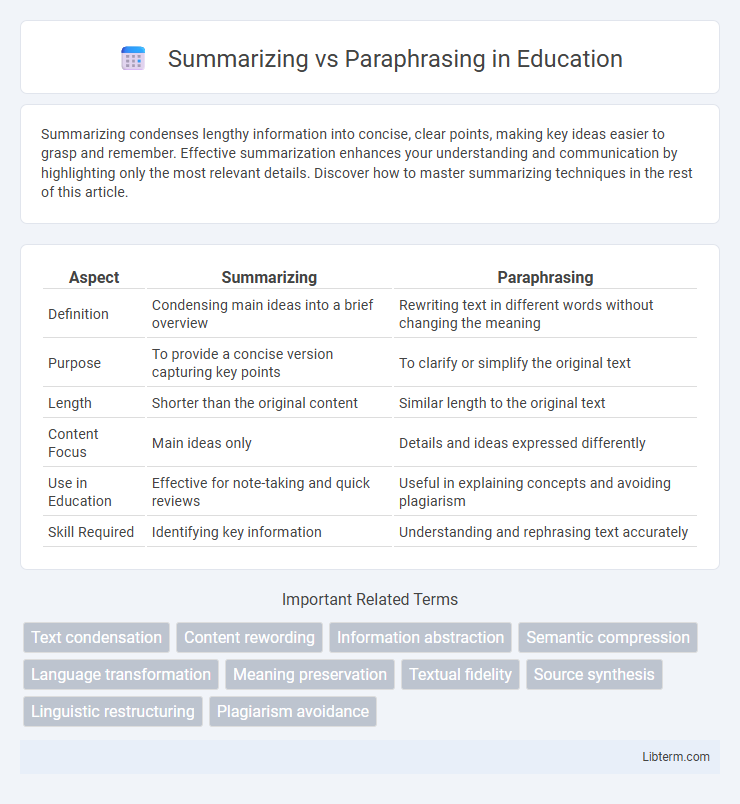Summarizing condenses lengthy information into concise, clear points, making key ideas easier to grasp and remember. Effective summarization enhances your understanding and communication by highlighting only the most relevant details. Discover how to master summarizing techniques in the rest of this article.
Table of Comparison
| Aspect | Summarizing | Paraphrasing |
|---|---|---|
| Definition | Condensing main ideas into a brief overview | Rewriting text in different words without changing the meaning |
| Purpose | To provide a concise version capturing key points | To clarify or simplify the original text |
| Length | Shorter than the original content | Similar length to the original text |
| Content Focus | Main ideas only | Details and ideas expressed differently |
| Use in Education | Effective for note-taking and quick reviews | Useful in explaining concepts and avoiding plagiarism |
| Skill Required | Identifying key information | Understanding and rephrasing text accurately |
Defining Summarizing and Paraphrasing
Summarizing involves condensing the main ideas of a text into a brief overview while maintaining the original meaning. Paraphrasing requires rewording and rephrasing the source material in one's own words without altering the core message. Both techniques are essential for effective writing and research, ensuring clarity and originality.
Key Differences Between Summarizing and Paraphrasing
Summarizing condenses the main ideas of a text into a brief overview, capturing the essential points without detailed information, while paraphrasing involves rewording a specific passage in roughly the same length to clarify or simplify the original content. Summaries reduce the text size significantly, often to less than one-third, whereas paraphrases maintain the original text length and detail. Both techniques require proper attribution to avoid plagiarism, but summarizing is ideal for highlighting core ideas, whereas paraphrasing allows in-depth explanation using different wording.
Purpose and Use Cases for Summarizing
Summarizing distills the main ideas of a text into a concise form, making it ideal for quickly conveying essential information or providing an overview in research papers, presentations, and executive reports. Its purpose is to reduce length while maintaining core meaning, benefiting readers who need a broad understanding without detailed explanation. Summarizing is frequently used in academic settings, business communication, and media to highlight key points efficiently.
When to Use Paraphrasing in Writing
Paraphrasing is essential when you need to clarify complex information or tailor the original content to fit your writing style while retaining the original meaning. Use paraphrasing to explain detailed concepts, integrate evidence smoothly, and avoid over-reliance on direct quotations in academic or professional writing. It helps maintain originality and prevents plagiarism by rephrasing source material accurately.
Techniques for Effective Summarizing
Effective summarizing techniques involve identifying the main ideas and key details while eliminating redundant or minor information. Use your own words to condense the original text, maintaining its core meaning and logical flow. Employ strategies like highlighting, note-taking, and outlining to organize information clearly and enhance comprehension.
Strategies for Accurate Paraphrasing
Effective strategies for accurate paraphrasing include thoroughly understanding the original text, identifying key concepts, and rephrasing ideas using different vocabulary and sentence structures without altering the meaning. Employing techniques like synonym substitution, changing sentence voice, and breaking complex sentences into simpler ones enhances clarity while maintaining the author's intent. Careful citation is essential to avoid plagiarism and ensure academic integrity in paraphrased content.
Common Mistakes in Summarizing and Paraphrasing
Common mistakes in summarizing include omitting key details, altering the original meaning, and failing to maintain the text's core message, which can lead to inaccuracies. In paraphrasing, errors often involve too closely mirroring the original phrasing, resulting in plagiarism, or changing terminology improperly, which distorts the author's intent. Both practices require careful balancing of brevity, originality, and fidelity to the source to ensure clear and ethical representation of the original information.
Benefits of Summarizing and Paraphrasing
Summarizing condenses large texts into concise overviews, enhancing comprehension and saving time by highlighting key points. Paraphrasing rephrases original content in new words, improving clarity and facilitating deeper understanding while avoiding plagiarism. Both techniques support effective communication and knowledge retention in academic and professional contexts.
Tools and Resources for Summarizing and Paraphrasing
Summarizing tools like SMMRY and Resoomer efficiently condense lengthy texts by extracting key points, while paraphrasing tools such as QuillBot and Spinbot rephrase content to maintain original meaning with unique wording. These AI-powered resources employ natural language processing algorithms to enhance clarity, coherence, and originality, making them invaluable for writers, students, and researchers. Integrating plagiarism checkers like Turnitin or Copyscape ensures the content remains authentic and properly attributed throughout the summarizing or paraphrasing process.
Ethical Considerations and Avoiding Plagiarism
Summarizing and paraphrasing require careful adherence to ethical standards to avoid plagiarism by properly crediting original sources. Accurate citation practices ensure the integrity of academic and professional work while respecting intellectual property rights. Misrepresentation of ideas through inadequate attribution compromises ethical responsibility and can lead to serious consequences.
Summarizing Infographic

 libterm.com
libterm.com